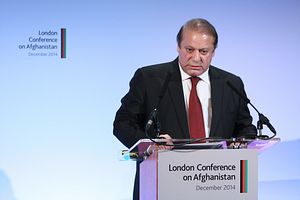After sweeping the general elections of 2013 with an overwhelming majority, Nawaz Sharif never would have expected the severe political tests to follow. However, only a year after becoming prime minister for a record third time, Nawaz Sharif found himself in troubled waters when the Punjab Police opened fire on protesters at the Pakistan Awaami Tehreek (PAT) headquarters in Lahore and killed 13 people in an alleged cross-firing. The PAT blamed the government for the carnage and demanded resignations from both Chief Minister Shahbaz Sharif (Nawaz Sharif’s brother) and the prime minster himself. Later the PAT turned violent and held a series of protests in big cities, ultimately joining hands with Pakistan Tehreek-i-Insaf (PTI) in its sit-in in Islamabad. The Imran Khan-led PTI, accusing Sharif of rigging the elections, staged a 126-day sit-in (dharna) in Islamabad. That long sit-in kept the stakes high and the Sharif regime remained under constant threat of being toppled by the “third force” since the sit-in leaders (Tahir Qadri and Imran Khan) repeatedly sought the army’s involvement to defuse the crisis. The sit-in ended however, without achieving any of the objectives and Nawaz Sharif found his government in a more comfortable zone.
With the demise of dharna politics, Sharif again assumed he could take control over political affairs, with smooth going till the next polls. But the Panama Papers issue surfaced in 2016, giving a potent jolt to the government. Old foes reemerged, recognizing a fine opportunity to besiege the Sharif government. PTI and the Pakistan People Party (PPP) started asking for the prime minister’s resignation and both parties flexed their political muscles in Parliament.
Additionally, PTI opted to pursue the case legally also and thus involved the Supreme Court. From the early hearings, it seemed Court was dissatisfied with the evidence filed by PTI and thus postponed the case until the appointment of new chief fustice. Meanwhile, Imran Khan’s hard-rolled Panama pitch is now diminishing and he has decided to go back on the road. The Panama question is not over yet but Sharif has chosen the new chief justice, signaling he still holds all legitimate power to appoint the heads of country’s powerful institutions.
What should be a normal practice in democracies, appointing a new Army Chief has become a headache for Pakistani prime minsters over the years. Sharif had to pick new Chief of Army Staff (COAS) this year, and that for a record fourth time. Although he previously had a bitter experience after picking a junior general (Pervez Musharraf, who later overthrew Sharfi in a coup) as COAS, the prime minister’s last selection, General Raheel Sharif, proved positive. Thus selecting junior general number four as the new army chief is no surprise. Prior to General Qamar Bajwa’s appointment as a new COAS, there was a wave of uncertainty as media outlets whispered about a possible extension to the term of General Sharif. Nawaz Sharif however, kept his cards well-arranged and revealed his pick only when the media speculation had died out. Amidst the Army’s discomfort over the implementation of National Action Plan (NAP) and the looming Dawn leak issue, Sharif surprised the pundits and picked a man of his choice.
A smooth entry into 2017 means the Pakistan Muslim League-Nawaz (PML-N) government is only a year away from the next general election. Local elections are the best springboard to capture support from average voters and provide confidence to grassroots-level party activists. Punjab province holds the most seats in the National Assembly, thus the conqueror of Punjab castle usually forms the government in the Center. PML-N will enter in 2017 holding 30 (out of 34) district governments of Punjab under its belt while PTI and PPP have nothing to show except a sorry scorecard. Additionally, Nawaz Sharif has personally picked many candidates running for city mayors and district chairmen after deeply studying their previous records and productive political utilization in the future.
Gradually yet substantially tackling Pakistan’s energy woes, Nawaz Sharif has lately decided to bring five regulatory bodies — the Oil and Gas Development Authority (OGRA), National Electric Power Company Limited (NEPRA), Pakistan Telecommunication Authority (PTA), Frequency Allocation Board (FAB), and Public Procurement Regulatory Authority (PPRA) — under the command of federal ministries. This means complete control and regulation over the pricing of the most consumed energy items, i.e. oil and natural gas. This move may not matter a lot for the general public but it does for the opposition parties. The decision was immediately rejected by PTI and PPP, calling it a means to utilize the resources and capitals of the independent regulatory bodies just when the general elections are approaching. This time, it is PPP that has decided to take the issue into the courts.
During PTI’s 2014 dharna politics, Nawaz Sharif was almost at the mercy of the other mainstream political parties, despite having a single majority in Parliament. In 2016, he awaits the court’s judgment about the Panama Papers. Yet by playing his cards thoughtfully and presenting evidence astutely, Sharif seems to have circumvented another bumpy patch. PML-N would not wish to go into 2018 polls with the scars of the Panama Papers and therefore, it may eagerly pursue the Panama case until cleared by the court.
The onus of appointing new COAS is over, PTI has lost its high ground (thanks to Imran Khan’s reliance on non-political tactics), and PPP is busy in reviving its lost glory. This not only allows smooth sailing for Nawaz Sharif but opens up the road to the 2018 polls, when he could become prime minister for the fourth time. Entering into the election year, Nawaz Sharif would never have imagined taking command despite all the hiccups but he has. This makes him powerful, for the first time, during his three rounds in the prime minister’s office.
Muhammad Daim Fazil is Lecturer of International Relations at University of Gujrat, Sialkot Campus, Pakistan. He was July 2016 Visiting Fellow at the Henry L. Stimson Center Washington D.C. He tweets @DaimFazil.

































